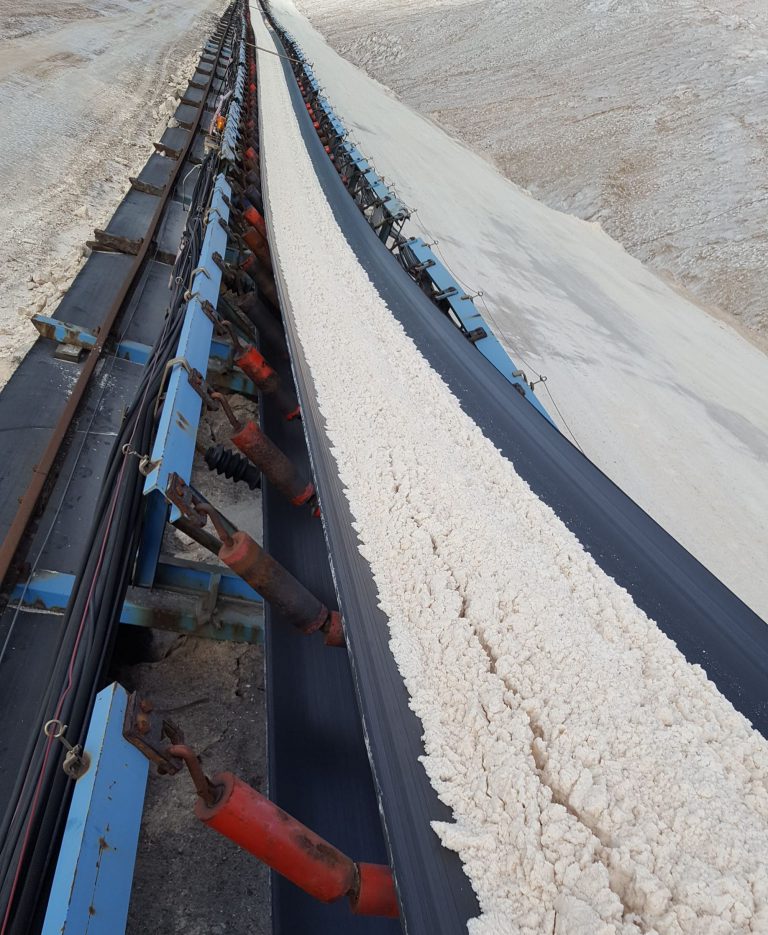The tracking of an out of centre running belt on a belt conveyor can be a very challenging task. In the following we provide a “How to Track a Conveyor Belt” with five easy to follow steps, which should improve you belt conveyor. You can find most common reasons for belt mistracking under the topic of Belt Mistracking of a Conveyor Belt.

Is the belt running centred if it is loaded or unloaded? If the belt is on off-track when loaded but centred when unloaded, the transfer chute should be checked at first. Is the bulk material transferred to a centred belt? Does the bulk material lie centred on the belt?
If the belt runs off centre while unloaded check the general appearance of the belt conveyor. Are the idler stations / garlands in line or are the sideways shifted. If yes try to bring everything in line as good as possible. If the belt still runs off centre while unloaded, mark the empty belt at a one point with a spray can, to keep track of the revolutions.
Observe the belt for at least two complete revolutions at the point of interest. Are there any zones in the belt that make bigger movements from side to side, or is the belt statically on one (off-centric) position? If YES: you are facing a belt with a problem. If there are zones with movement mark them with arrows on the belt in direction of the moment. Beginning of the movement – against the running direction, end of movement – an arrow in conveying direction. After this inspect the zone between the arrows carefully. If there are damages of the belt or a belt connection, it is likely that this causes the problem. In every belt connection a little variation of the splice angle is present. If possible cut the connection out of the belt and replace it with a straight one. Another method to find this kind of problem is to film the belt edge with a camera on a tripod and do a fast forward play afterwards. The belt tracking signature will become visible.
If the belt is statically of centred, it is likely that the alignment of the idlers is not ideal. Now start to skew idler stations or garlands around the vertical axis against the belt to push the belt away from the point where the problem occurs. The manipulated idler should be 5 to 10 m in front of the problem spot. Wait for at least three complete revolutions of the belt while observerving continuously the problem spot.
If there is not a certain spot of a tracking problem and mistracking occurs randomly, idlers should be tilted forwards. Do not exceed 3°, also it is better to tilt a few more idler stations a once with lower angles. Do not set every idler on tilt because tilting increases the friction, wear and power consumption of the conveyor dramatically.Wait for at least three complete revolutions of the belt while observerving continuously the problem spot.
If these five steps are not sufficient for your conveyor, one possibility would be the simulation of the belt running behaviour in a computer model to plan the counter actions. However, it is also possible to centre the belt using tracking devices.
 Privacy Preference
Privacy Preference
We use cookies on our website. Some of them are essential, while others help us to improve this website and your experience.

Here you will find an overview of all cookies used. You can give your consent to whole categories or display further information and select certain cookies.
Essential cookies enable basic functions and are necessary for the proper function of the website.
| Name | |
|---|---|
| Provider | Owner of this website |
| Purpose | Saves the visitors preferences selected in the Cookie Box of Borlabs Cookie. |
| Cookie Name | borlabs-cookie |
| Cookie Expiry | 1 Year |
Marketing cookies are used by third-party advertisers or publishers to display personalized ads. They do this by tracking visitors across websites.
| Accept | |
|---|---|
| Name | |
| Provider | Google LLC |
| Purpose | Cookie by Google used for website analytics. Generates statistical data on how the visitor uses the website. |
| Privacy Policy | https://policies.google.com/privacy?hl=en |
| Host(s) | |
| Cookie Name | _ga,_gat,_gid |
| Cookie Expiry | 2 Years |
Content from video platforms and social media platforms is blocked by default. If External Media cookies are accepted, access to those contents no longer requires manual consent.
| Accept | |
|---|---|
| Name | |
| Provider | YouTube |
| Purpose | Used to unblock YouTube content. |
| Privacy Policy | https://policies.google.com/privacy?hl=en&gl=en |
| Host(s) | google.com |
| Cookie Name | NID |
| Cookie Expiry | 6 Month |